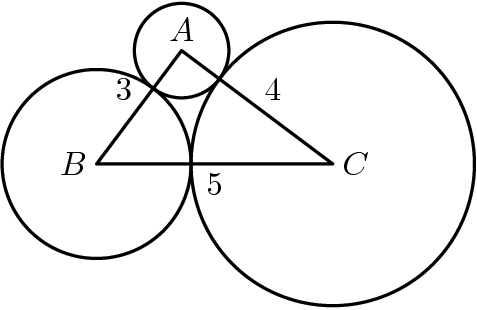Difference between revisions of "2006 AMC 12A Problems/Problem 13"
(added link to previous and next problem) |
m (moved image below problem statement) |
||
| (6 intermediate revisions by 5 users not shown) | |||
| Line 1: | Line 1: | ||
== Problem == | == Problem == | ||
| + | The [[vertex|vertices]] of a <math>3-4-5</math> [[right triangle]] are the centers of three mutually externally tangent [[circle]]s, as shown. What is the sum of the areas of the three circles? | ||
| − | [[Image: | + | [[Image:Original_2006_12A_13.png]] |
| − | |||
| − | |||
<math> \mathrm{(A) \ } 12\pi\qquad \mathrm{(B) \ } \frac{25\pi}{2}\qquad \mathrm{(C) \ } 13\pi\qquad \mathrm{(D) \ } \frac{27\pi}{2}\qquad\mathrm{(E) \ } 14\pi</math> | <math> \mathrm{(A) \ } 12\pi\qquad \mathrm{(B) \ } \frac{25\pi}{2}\qquad \mathrm{(C) \ } 13\pi\qquad \mathrm{(D) \ } \frac{27\pi}{2}\qquad\mathrm{(E) \ } 14\pi</math> | ||
== Solution == | == Solution == | ||
| + | Let the radius of the smallest circle be <math>r_A</math>, the radius of the second largest circle be <math>r_B</math>, and the radius of the largest circle be <math>r_C</math>. | ||
| + | <cmath>r_A + r_B = 3</cmath> | ||
| + | <cmath>r_A + r_C = 4</cmath> | ||
| + | <cmath>r_ B + r_C = 5</cmath> | ||
| − | + | Adding up all these equations and then dividing both sides by 2, we get, | |
| + | |||
| + | <cmath>r_A + r_B + r_C = 6</cmath> | ||
| + | |||
| + | Then, we get <math>r_A = 1</math>, <math>r_B = 2</math>, and <math>r_C = 3</math> Then we get <math>1^2 \pi + 2^2 \pi + 3^2 \pi = 14 \pi \iff\mathrm{(E)}</math> | ||
== See also == | == See also == | ||
* [[2006 AMC 12A Problems]] | * [[2006 AMC 12A Problems]] | ||
| − | + | ||
| − | + | {{AMC12 box|year=2006|ab=A|num-b=12|num-a=14}} | |
| + | {{MAA Notice}} | ||
| + | |||
| + | [[Category:Introductory Geometry Problems]] | ||
Latest revision as of 12:57, 19 January 2021
Problem
The vertices of a ![]() right triangle are the centers of three mutually externally tangent circles, as shown. What is the sum of the areas of the three circles?
right triangle are the centers of three mutually externally tangent circles, as shown. What is the sum of the areas of the three circles?
![]()
Solution
Let the radius of the smallest circle be ![]() , the radius of the second largest circle be
, the radius of the second largest circle be ![]() , and the radius of the largest circle be
, and the radius of the largest circle be ![]() .
.
![]()
![]()
![]()
Adding up all these equations and then dividing both sides by 2, we get,
![]()
Then, we get ![]() ,
, ![]() , and
, and ![]() Then we get
Then we get ![]()
See also
| 2006 AMC 12A (Problems • Answer Key • Resources) | |
| Preceded by Problem 12 |
Followed by Problem 14 |
| 1 • 2 • 3 • 4 • 5 • 6 • 7 • 8 • 9 • 10 • 11 • 12 • 13 • 14 • 15 • 16 • 17 • 18 • 19 • 20 • 21 • 22 • 23 • 24 • 25 | |
| All AMC 12 Problems and Solutions | |
The problems on this page are copyrighted by the Mathematical Association of America's American Mathematics Competitions. 










